Business Ethics, Corporate Responsibility and Sustainability Assignment
VerifiedAdded on 2021/02/20
|13
|3512
|63
AI Summary
Contribute Materials
Your contribution can guide someone’s learning journey. Share your
documents today.
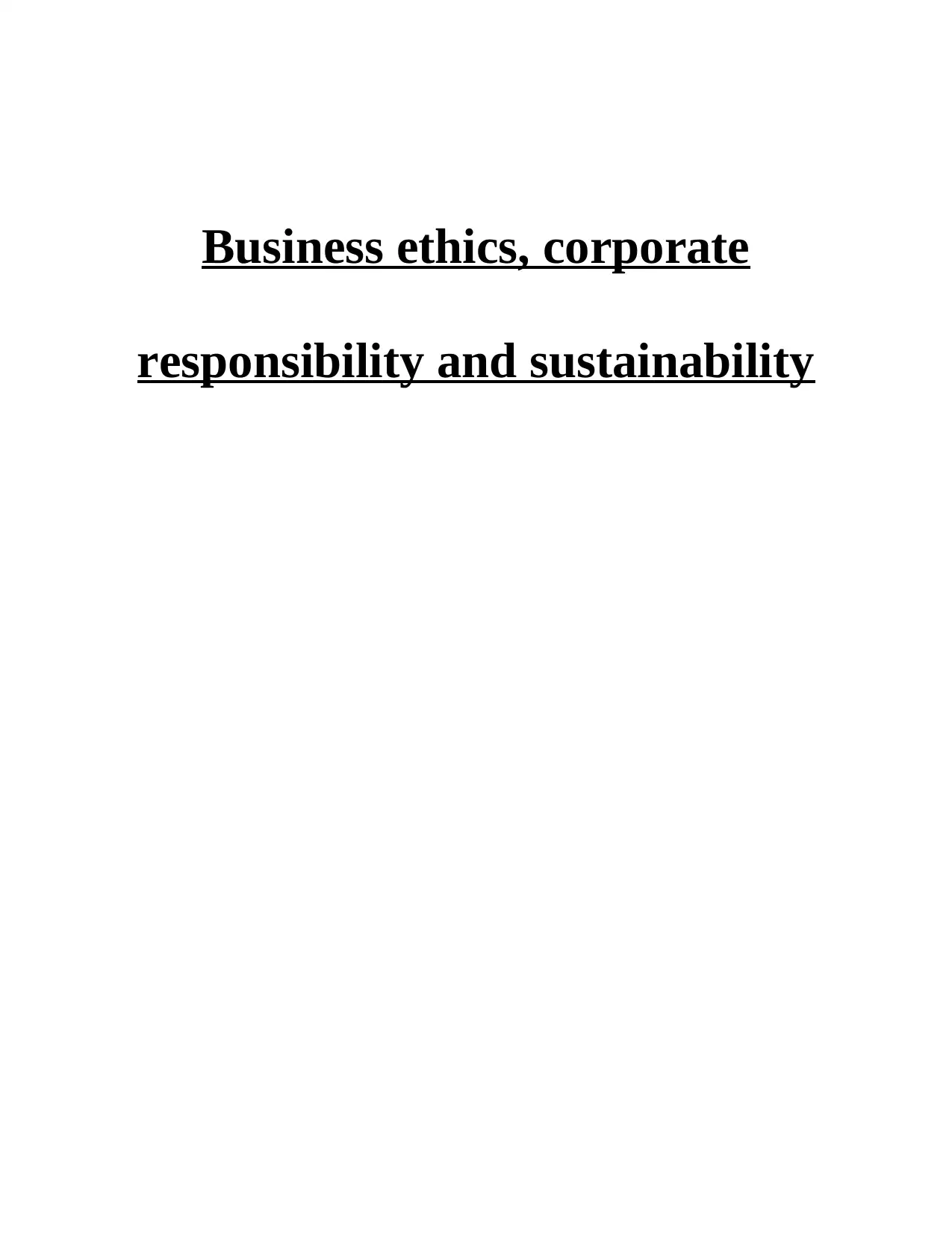
Business ethics, corporate
responsibility and sustainability
responsibility and sustainability
Secure Best Marks with AI Grader
Need help grading? Try our AI Grader for instant feedback on your assignments.
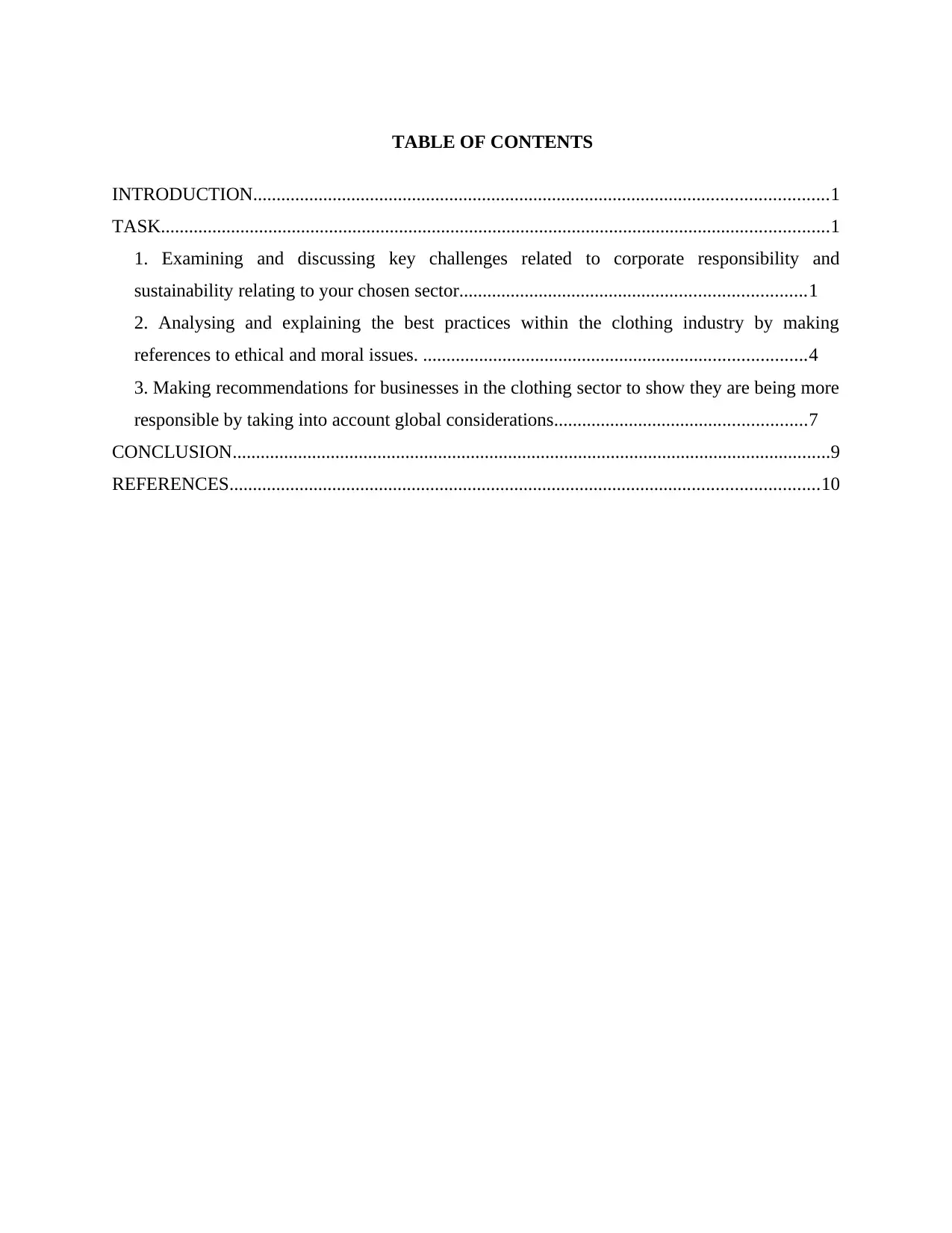
TABLE OF CONTENTS
INTRODUCTION...........................................................................................................................1
TASK...............................................................................................................................................1
1. Examining and discussing key challenges related to corporate responsibility and
sustainability relating to your chosen sector..........................................................................1
2. Analysing and explaining the best practices within the clothing industry by making
references to ethical and moral issues. ..................................................................................4
3. Making recommendations for businesses in the clothing sector to show they are being more
responsible by taking into account global considerations......................................................7
CONCLUSION................................................................................................................................9
REFERENCES..............................................................................................................................10
INTRODUCTION...........................................................................................................................1
TASK...............................................................................................................................................1
1. Examining and discussing key challenges related to corporate responsibility and
sustainability relating to your chosen sector..........................................................................1
2. Analysing and explaining the best practices within the clothing industry by making
references to ethical and moral issues. ..................................................................................4
3. Making recommendations for businesses in the clothing sector to show they are being more
responsible by taking into account global considerations......................................................7
CONCLUSION................................................................................................................................9
REFERENCES..............................................................................................................................10
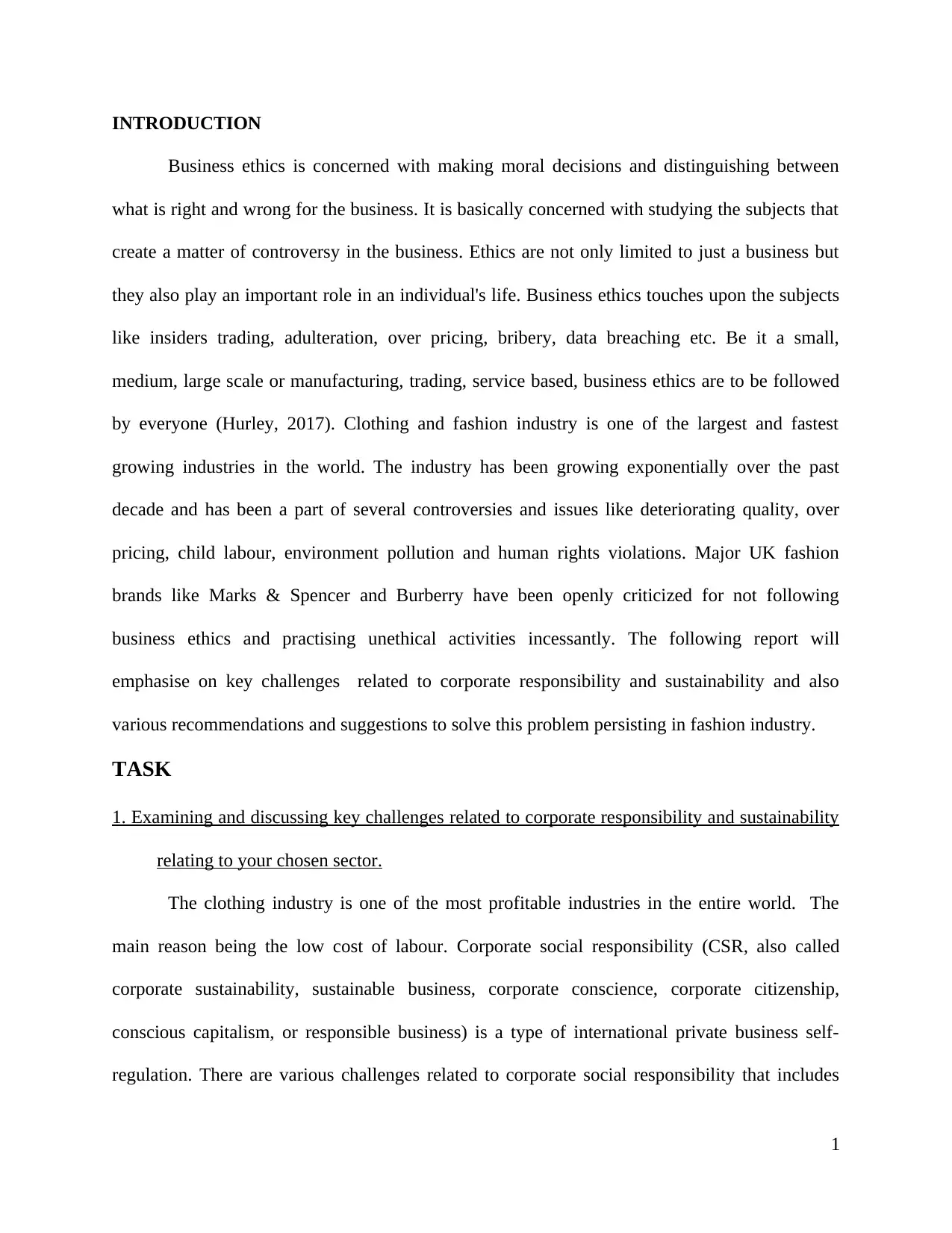
INTRODUCTION
Business ethics is concerned with making moral decisions and distinguishing between
what is right and wrong for the business. It is basically concerned with studying the subjects that
create a matter of controversy in the business. Ethics are not only limited to just a business but
they also play an important role in an individual's life. Business ethics touches upon the subjects
like insiders trading, adulteration, over pricing, bribery, data breaching etc. Be it a small,
medium, large scale or manufacturing, trading, service based, business ethics are to be followed
by everyone (Hurley, 2017). Clothing and fashion industry is one of the largest and fastest
growing industries in the world. The industry has been growing exponentially over the past
decade and has been a part of several controversies and issues like deteriorating quality, over
pricing, child labour, environment pollution and human rights violations. Major UK fashion
brands like Marks & Spencer and Burberry have been openly criticized for not following
business ethics and practising unethical activities incessantly. The following report will
emphasise on key challenges related to corporate responsibility and sustainability and also
various recommendations and suggestions to solve this problem persisting in fashion industry.
TASK
1. Examining and discussing key challenges related to corporate responsibility and sustainability
relating to your chosen sector.
The clothing industry is one of the most profitable industries in the entire world. The
main reason being the low cost of labour. Corporate social responsibility (CSR, also called
corporate sustainability, sustainable business, corporate conscience, corporate citizenship,
conscious capitalism, or responsible business) is a type of international private business self-
regulation. There are various challenges related to corporate social responsibility that includes
1
Business ethics is concerned with making moral decisions and distinguishing between
what is right and wrong for the business. It is basically concerned with studying the subjects that
create a matter of controversy in the business. Ethics are not only limited to just a business but
they also play an important role in an individual's life. Business ethics touches upon the subjects
like insiders trading, adulteration, over pricing, bribery, data breaching etc. Be it a small,
medium, large scale or manufacturing, trading, service based, business ethics are to be followed
by everyone (Hurley, 2017). Clothing and fashion industry is one of the largest and fastest
growing industries in the world. The industry has been growing exponentially over the past
decade and has been a part of several controversies and issues like deteriorating quality, over
pricing, child labour, environment pollution and human rights violations. Major UK fashion
brands like Marks & Spencer and Burberry have been openly criticized for not following
business ethics and practising unethical activities incessantly. The following report will
emphasise on key challenges related to corporate responsibility and sustainability and also
various recommendations and suggestions to solve this problem persisting in fashion industry.
TASK
1. Examining and discussing key challenges related to corporate responsibility and sustainability
relating to your chosen sector.
The clothing industry is one of the most profitable industries in the entire world. The
main reason being the low cost of labour. Corporate social responsibility (CSR, also called
corporate sustainability, sustainable business, corporate conscience, corporate citizenship,
conscious capitalism, or responsible business) is a type of international private business self-
regulation. There are various challenges related to corporate social responsibility that includes
1
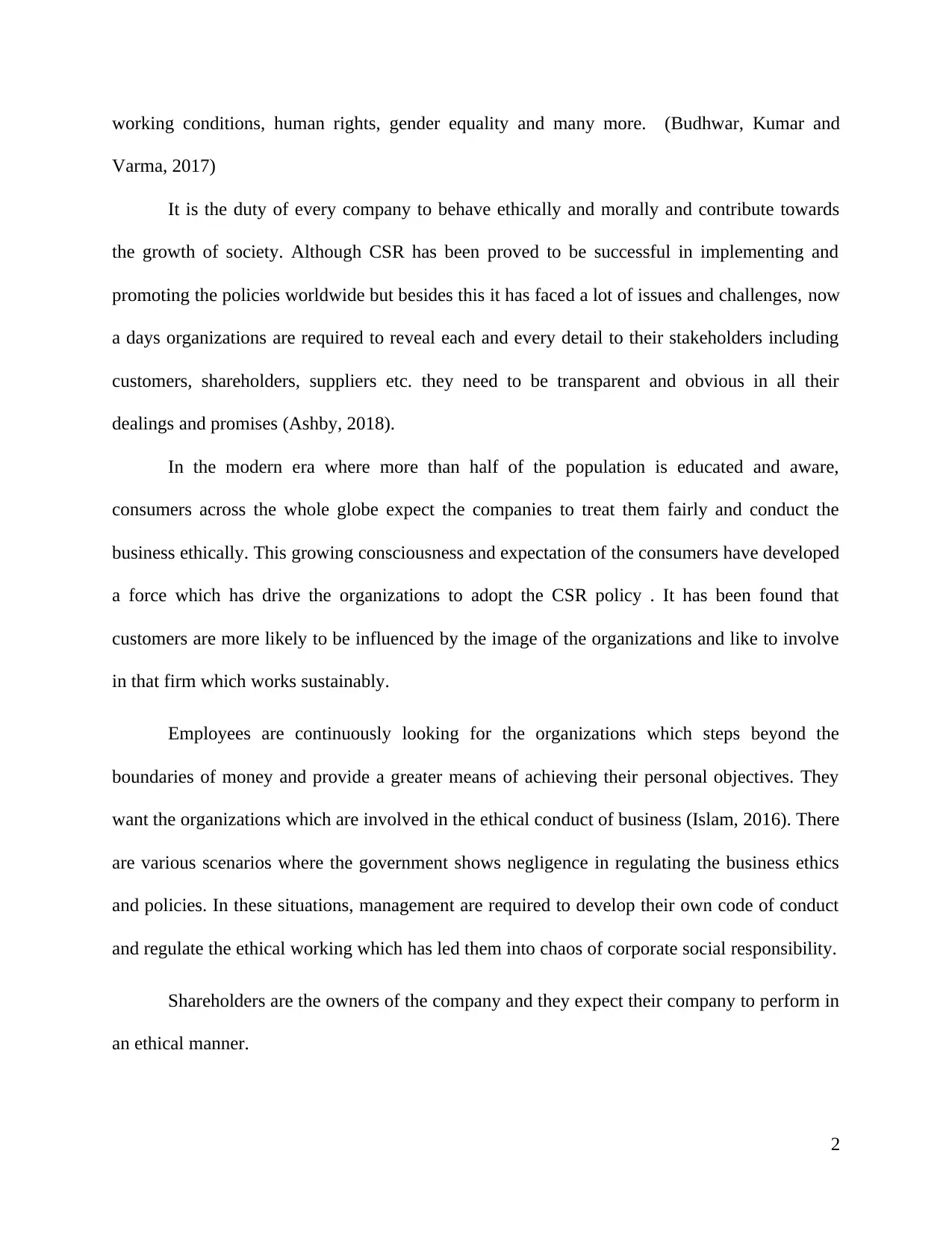
working conditions, human rights, gender equality and many more. (Budhwar, Kumar and
Varma, 2017)
It is the duty of every company to behave ethically and morally and contribute towards
the growth of society. Although CSR has been proved to be successful in implementing and
promoting the policies worldwide but besides this it has faced a lot of issues and challenges, now
a days organizations are required to reveal each and every detail to their stakeholders including
customers, shareholders, suppliers etc. they need to be transparent and obvious in all their
dealings and promises (Ashby, 2018).
In the modern era where more than half of the population is educated and aware,
consumers across the whole globe expect the companies to treat them fairly and conduct the
business ethically. This growing consciousness and expectation of the consumers have developed
a force which has drive the organizations to adopt the CSR policy . It has been found that
customers are more likely to be influenced by the image of the organizations and like to involve
in that firm which works sustainably.
Employees are continuously looking for the organizations which steps beyond the
boundaries of money and provide a greater means of achieving their personal objectives. They
want the organizations which are involved in the ethical conduct of business (Islam, 2016). There
are various scenarios where the government shows negligence in regulating the business ethics
and policies. In these situations, management are required to develop their own code of conduct
and regulate the ethical working which has led them into chaos of corporate social responsibility.
Shareholders are the owners of the company and they expect their company to perform in
an ethical manner.
2
Varma, 2017)
It is the duty of every company to behave ethically and morally and contribute towards
the growth of society. Although CSR has been proved to be successful in implementing and
promoting the policies worldwide but besides this it has faced a lot of issues and challenges, now
a days organizations are required to reveal each and every detail to their stakeholders including
customers, shareholders, suppliers etc. they need to be transparent and obvious in all their
dealings and promises (Ashby, 2018).
In the modern era where more than half of the population is educated and aware,
consumers across the whole globe expect the companies to treat them fairly and conduct the
business ethically. This growing consciousness and expectation of the consumers have developed
a force which has drive the organizations to adopt the CSR policy . It has been found that
customers are more likely to be influenced by the image of the organizations and like to involve
in that firm which works sustainably.
Employees are continuously looking for the organizations which steps beyond the
boundaries of money and provide a greater means of achieving their personal objectives. They
want the organizations which are involved in the ethical conduct of business (Islam, 2016). There
are various scenarios where the government shows negligence in regulating the business ethics
and policies. In these situations, management are required to develop their own code of conduct
and regulate the ethical working which has led them into chaos of corporate social responsibility.
Shareholders are the owners of the company and they expect their company to perform in
an ethical manner.
2
Secure Best Marks with AI Grader
Need help grading? Try our AI Grader for instant feedback on your assignments.
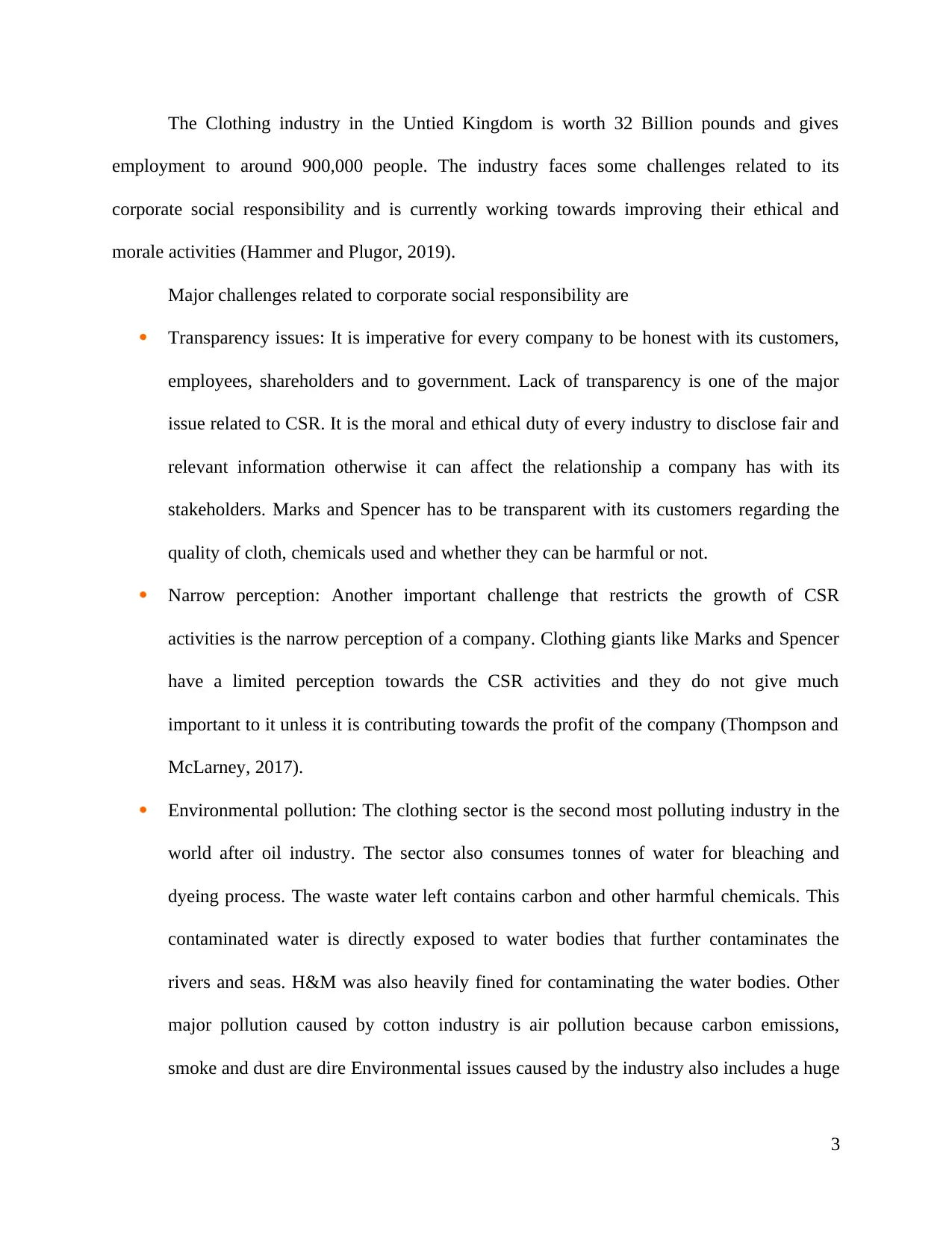
The Clothing industry in the Untied Kingdom is worth 32 Billion pounds and gives
employment to around 900,000 people. The industry faces some challenges related to its
corporate social responsibility and is currently working towards improving their ethical and
morale activities (Hammer and Plugor, 2019).
Major challenges related to corporate social responsibility are
Transparency issues: It is imperative for every company to be honest with its customers,
employees, shareholders and to government. Lack of transparency is one of the major
issue related to CSR. It is the moral and ethical duty of every industry to disclose fair and
relevant information otherwise it can affect the relationship a company has with its
stakeholders. Marks and Spencer has to be transparent with its customers regarding the
quality of cloth, chemicals used and whether they can be harmful or not.
Narrow perception: Another important challenge that restricts the growth of CSR
activities is the narrow perception of a company. Clothing giants like Marks and Spencer
have a limited perception towards the CSR activities and they do not give much
important to it unless it is contributing towards the profit of the company (Thompson and
McLarney, 2017).
Environmental pollution: The clothing sector is the second most polluting industry in the
world after oil industry. The sector also consumes tonnes of water for bleaching and
dyeing process. The waste water left contains carbon and other harmful chemicals. This
contaminated water is directly exposed to water bodies that further contaminates the
rivers and seas. H&M was also heavily fined for contaminating the water bodies. Other
major pollution caused by cotton industry is air pollution because carbon emissions,
smoke and dust are dire Environmental issues caused by the industry also includes a huge
3
employment to around 900,000 people. The industry faces some challenges related to its
corporate social responsibility and is currently working towards improving their ethical and
morale activities (Hammer and Plugor, 2019).
Major challenges related to corporate social responsibility are
Transparency issues: It is imperative for every company to be honest with its customers,
employees, shareholders and to government. Lack of transparency is one of the major
issue related to CSR. It is the moral and ethical duty of every industry to disclose fair and
relevant information otherwise it can affect the relationship a company has with its
stakeholders. Marks and Spencer has to be transparent with its customers regarding the
quality of cloth, chemicals used and whether they can be harmful or not.
Narrow perception: Another important challenge that restricts the growth of CSR
activities is the narrow perception of a company. Clothing giants like Marks and Spencer
have a limited perception towards the CSR activities and they do not give much
important to it unless it is contributing towards the profit of the company (Thompson and
McLarney, 2017).
Environmental pollution: The clothing sector is the second most polluting industry in the
world after oil industry. The sector also consumes tonnes of water for bleaching and
dyeing process. The waste water left contains carbon and other harmful chemicals. This
contaminated water is directly exposed to water bodies that further contaminates the
rivers and seas. H&M was also heavily fined for contaminating the water bodies. Other
major pollution caused by cotton industry is air pollution because carbon emissions,
smoke and dust are dire Environmental issues caused by the industry also includes a huge
3
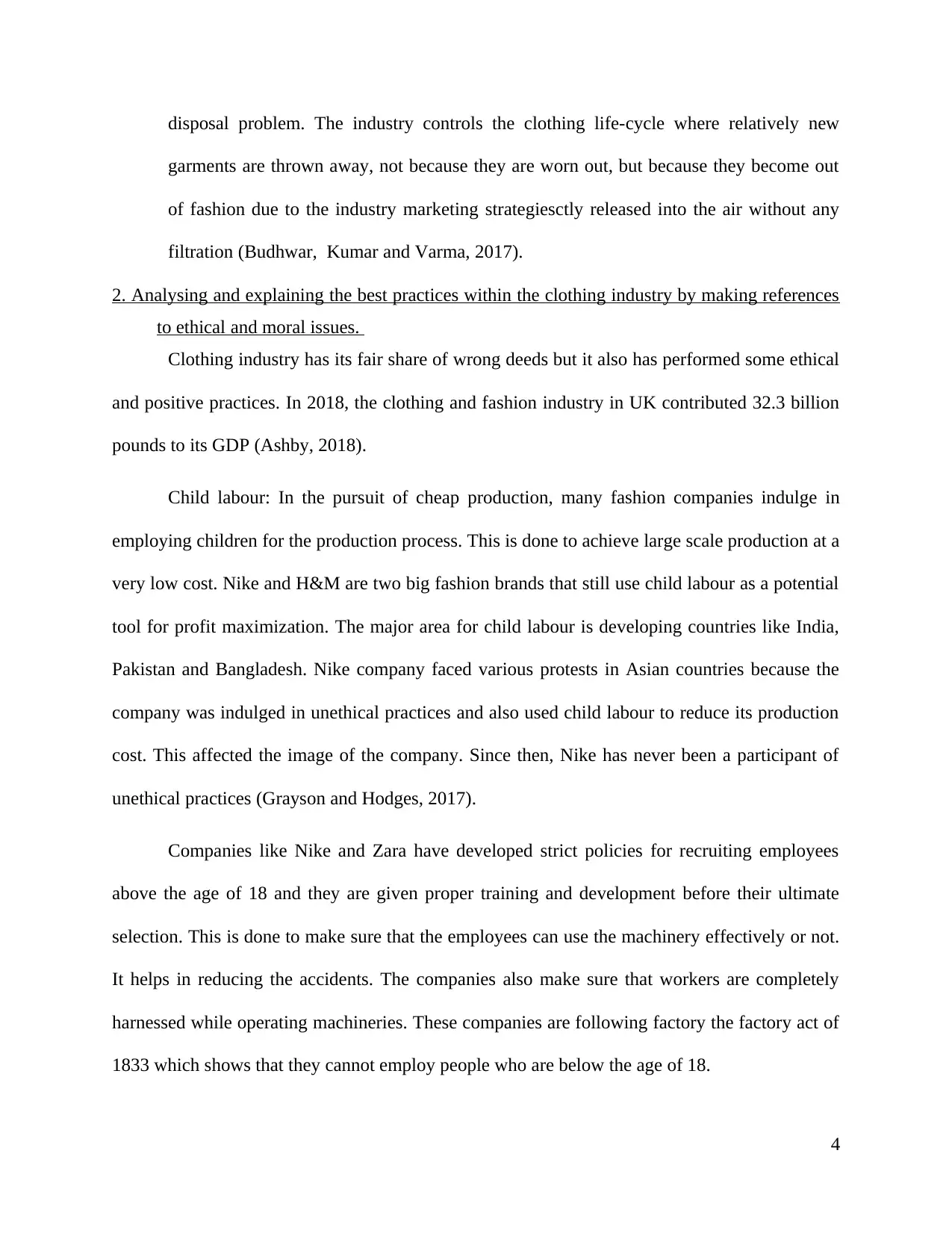
disposal problem. The industry controls the clothing life-cycle where relatively new
garments are thrown away, not because they are worn out, but because they become out
of fashion due to the industry marketing strategiesctly released into the air without any
filtration (Budhwar, Kumar and Varma, 2017).
2. Analysing and explaining the best practices within the clothing industry by making references
to ethical and moral issues.
Clothing industry has its fair share of wrong deeds but it also has performed some ethical
and positive practices. In 2018, the clothing and fashion industry in UK contributed 32.3 billion
pounds to its GDP (Ashby, 2018).
Child labour: In the pursuit of cheap production, many fashion companies indulge in
employing children for the production process. This is done to achieve large scale production at a
very low cost. Nike and H&M are two big fashion brands that still use child labour as a potential
tool for profit maximization. The major area for child labour is developing countries like India,
Pakistan and Bangladesh. Nike company faced various protests in Asian countries because the
company was indulged in unethical practices and also used child labour to reduce its production
cost. This affected the image of the company. Since then, Nike has never been a participant of
unethical practices (Grayson and Hodges, 2017).
Companies like Nike and Zara have developed strict policies for recruiting employees
above the age of 18 and they are given proper training and development before their ultimate
selection. This is done to make sure that the employees can use the machinery effectively or not.
It helps in reducing the accidents. The companies also make sure that workers are completely
harnessed while operating machineries. These companies are following factory the factory act of
1833 which shows that they cannot employ people who are below the age of 18.
4
garments are thrown away, not because they are worn out, but because they become out
of fashion due to the industry marketing strategiesctly released into the air without any
filtration (Budhwar, Kumar and Varma, 2017).
2. Analysing and explaining the best practices within the clothing industry by making references
to ethical and moral issues.
Clothing industry has its fair share of wrong deeds but it also has performed some ethical
and positive practices. In 2018, the clothing and fashion industry in UK contributed 32.3 billion
pounds to its GDP (Ashby, 2018).
Child labour: In the pursuit of cheap production, many fashion companies indulge in
employing children for the production process. This is done to achieve large scale production at a
very low cost. Nike and H&M are two big fashion brands that still use child labour as a potential
tool for profit maximization. The major area for child labour is developing countries like India,
Pakistan and Bangladesh. Nike company faced various protests in Asian countries because the
company was indulged in unethical practices and also used child labour to reduce its production
cost. This affected the image of the company. Since then, Nike has never been a participant of
unethical practices (Grayson and Hodges, 2017).
Companies like Nike and Zara have developed strict policies for recruiting employees
above the age of 18 and they are given proper training and development before their ultimate
selection. This is done to make sure that the employees can use the machinery effectively or not.
It helps in reducing the accidents. The companies also make sure that workers are completely
harnessed while operating machineries. These companies are following factory the factory act of
1833 which shows that they cannot employ people who are below the age of 18.
4
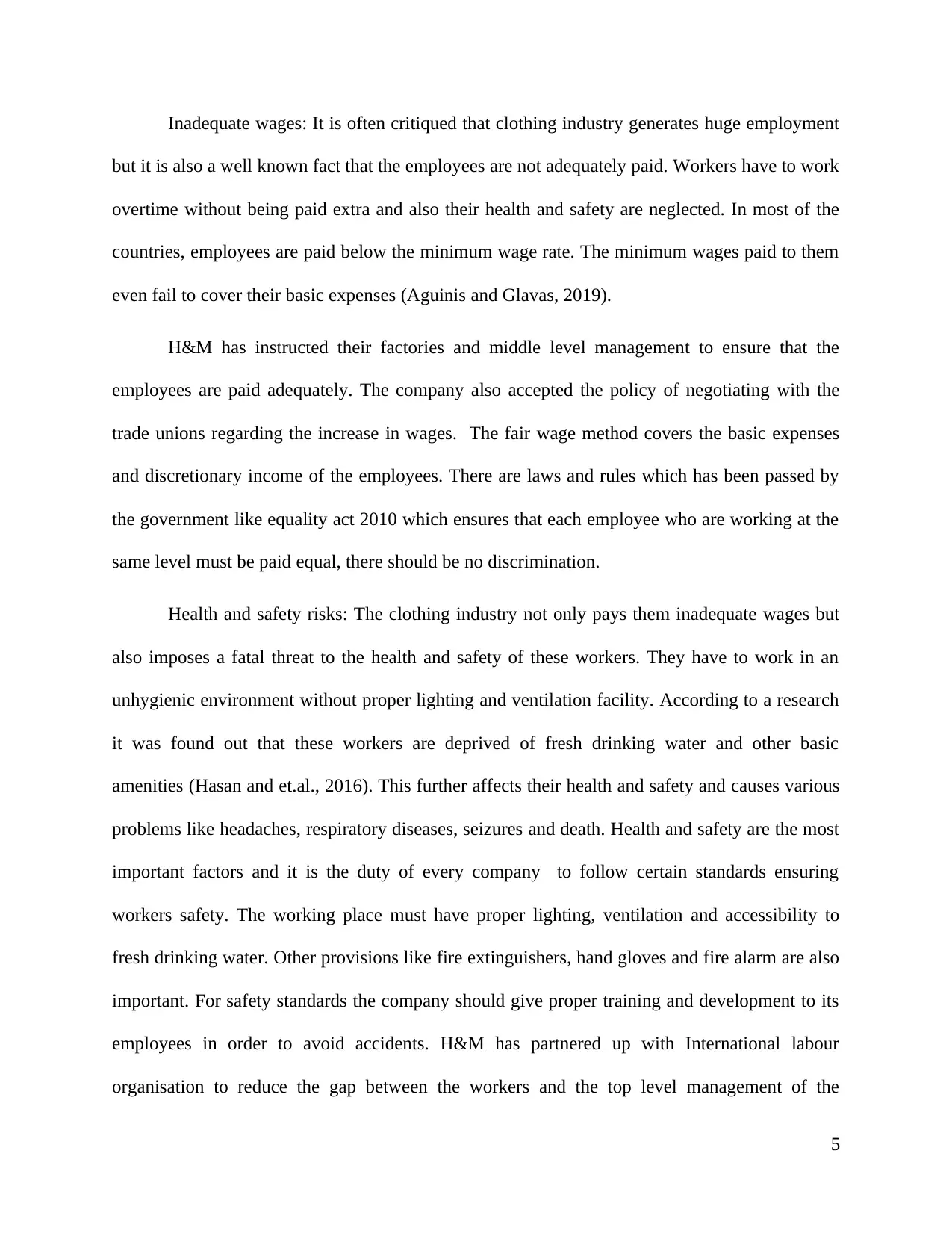
Inadequate wages: It is often critiqued that clothing industry generates huge employment
but it is also a well known fact that the employees are not adequately paid. Workers have to work
overtime without being paid extra and also their health and safety are neglected. In most of the
countries, employees are paid below the minimum wage rate. The minimum wages paid to them
even fail to cover their basic expenses (Aguinis and Glavas, 2019).
H&M has instructed their factories and middle level management to ensure that the
employees are paid adequately. The company also accepted the policy of negotiating with the
trade unions regarding the increase in wages. The fair wage method covers the basic expenses
and discretionary income of the employees. There are laws and rules which has been passed by
the government like equality act 2010 which ensures that each employee who are working at the
same level must be paid equal, there should be no discrimination.
Health and safety risks: The clothing industry not only pays them inadequate wages but
also imposes a fatal threat to the health and safety of these workers. They have to work in an
unhygienic environment without proper lighting and ventilation facility. According to a research
it was found out that these workers are deprived of fresh drinking water and other basic
amenities (Hasan and et.al., 2016). This further affects their health and safety and causes various
problems like headaches, respiratory diseases, seizures and death. Health and safety are the most
important factors and it is the duty of every company to follow certain standards ensuring
workers safety. The working place must have proper lighting, ventilation and accessibility to
fresh drinking water. Other provisions like fire extinguishers, hand gloves and fire alarm are also
important. For safety standards the company should give proper training and development to its
employees in order to avoid accidents. H&M has partnered up with International labour
organisation to reduce the gap between the workers and the top level management of the
5
but it is also a well known fact that the employees are not adequately paid. Workers have to work
overtime without being paid extra and also their health and safety are neglected. In most of the
countries, employees are paid below the minimum wage rate. The minimum wages paid to them
even fail to cover their basic expenses (Aguinis and Glavas, 2019).
H&M has instructed their factories and middle level management to ensure that the
employees are paid adequately. The company also accepted the policy of negotiating with the
trade unions regarding the increase in wages. The fair wage method covers the basic expenses
and discretionary income of the employees. There are laws and rules which has been passed by
the government like equality act 2010 which ensures that each employee who are working at the
same level must be paid equal, there should be no discrimination.
Health and safety risks: The clothing industry not only pays them inadequate wages but
also imposes a fatal threat to the health and safety of these workers. They have to work in an
unhygienic environment without proper lighting and ventilation facility. According to a research
it was found out that these workers are deprived of fresh drinking water and other basic
amenities (Hasan and et.al., 2016). This further affects their health and safety and causes various
problems like headaches, respiratory diseases, seizures and death. Health and safety are the most
important factors and it is the duty of every company to follow certain standards ensuring
workers safety. The working place must have proper lighting, ventilation and accessibility to
fresh drinking water. Other provisions like fire extinguishers, hand gloves and fire alarm are also
important. For safety standards the company should give proper training and development to its
employees in order to avoid accidents. H&M has partnered up with International labour
organisation to reduce the gap between the workers and the top level management of the
5
Paraphrase This Document
Need a fresh take? Get an instant paraphrase of this document with our AI Paraphraser
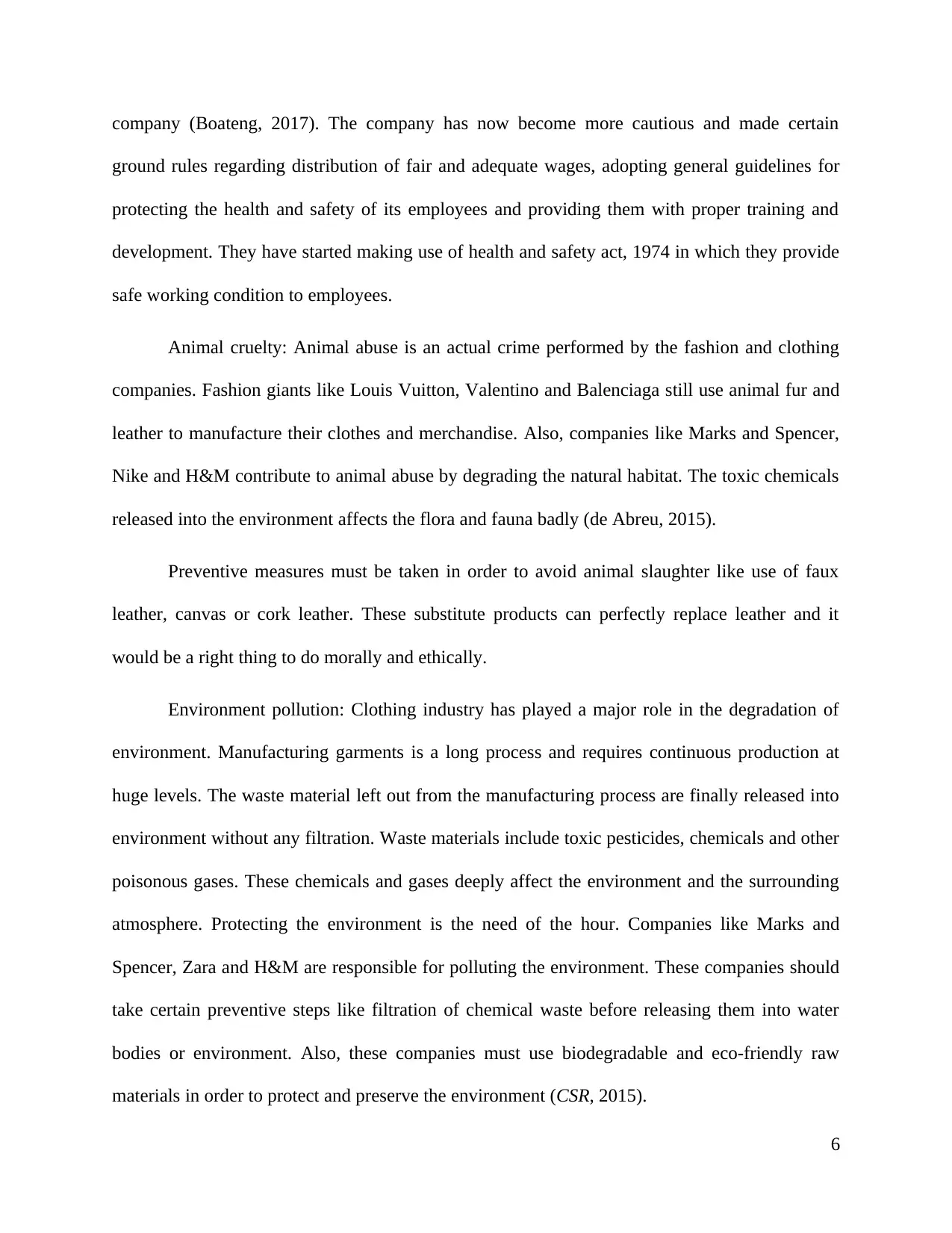
company (Boateng, 2017). The company has now become more cautious and made certain
ground rules regarding distribution of fair and adequate wages, adopting general guidelines for
protecting the health and safety of its employees and providing them with proper training and
development. They have started making use of health and safety act, 1974 in which they provide
safe working condition to employees.
Animal cruelty: Animal abuse is an actual crime performed by the fashion and clothing
companies. Fashion giants like Louis Vuitton, Valentino and Balenciaga still use animal fur and
leather to manufacture their clothes and merchandise. Also, companies like Marks and Spencer,
Nike and H&M contribute to animal abuse by degrading the natural habitat. The toxic chemicals
released into the environment affects the flora and fauna badly (de Abreu, 2015).
Preventive measures must be taken in order to avoid animal slaughter like use of faux
leather, canvas or cork leather. These substitute products can perfectly replace leather and it
would be a right thing to do morally and ethically.
Environment pollution: Clothing industry has played a major role in the degradation of
environment. Manufacturing garments is a long process and requires continuous production at
huge levels. The waste material left out from the manufacturing process are finally released into
environment without any filtration. Waste materials include toxic pesticides, chemicals and other
poisonous gases. These chemicals and gases deeply affect the environment and the surrounding
atmosphere. Protecting the environment is the need of the hour. Companies like Marks and
Spencer, Zara and H&M are responsible for polluting the environment. These companies should
take certain preventive steps like filtration of chemical waste before releasing them into water
bodies or environment. Also, these companies must use biodegradable and eco-friendly raw
materials in order to protect and preserve the environment (CSR, 2015).
6
ground rules regarding distribution of fair and adequate wages, adopting general guidelines for
protecting the health and safety of its employees and providing them with proper training and
development. They have started making use of health and safety act, 1974 in which they provide
safe working condition to employees.
Animal cruelty: Animal abuse is an actual crime performed by the fashion and clothing
companies. Fashion giants like Louis Vuitton, Valentino and Balenciaga still use animal fur and
leather to manufacture their clothes and merchandise. Also, companies like Marks and Spencer,
Nike and H&M contribute to animal abuse by degrading the natural habitat. The toxic chemicals
released into the environment affects the flora and fauna badly (de Abreu, 2015).
Preventive measures must be taken in order to avoid animal slaughter like use of faux
leather, canvas or cork leather. These substitute products can perfectly replace leather and it
would be a right thing to do morally and ethically.
Environment pollution: Clothing industry has played a major role in the degradation of
environment. Manufacturing garments is a long process and requires continuous production at
huge levels. The waste material left out from the manufacturing process are finally released into
environment without any filtration. Waste materials include toxic pesticides, chemicals and other
poisonous gases. These chemicals and gases deeply affect the environment and the surrounding
atmosphere. Protecting the environment is the need of the hour. Companies like Marks and
Spencer, Zara and H&M are responsible for polluting the environment. These companies should
take certain preventive steps like filtration of chemical waste before releasing them into water
bodies or environment. Also, these companies must use biodegradable and eco-friendly raw
materials in order to protect and preserve the environment (CSR, 2015).
6
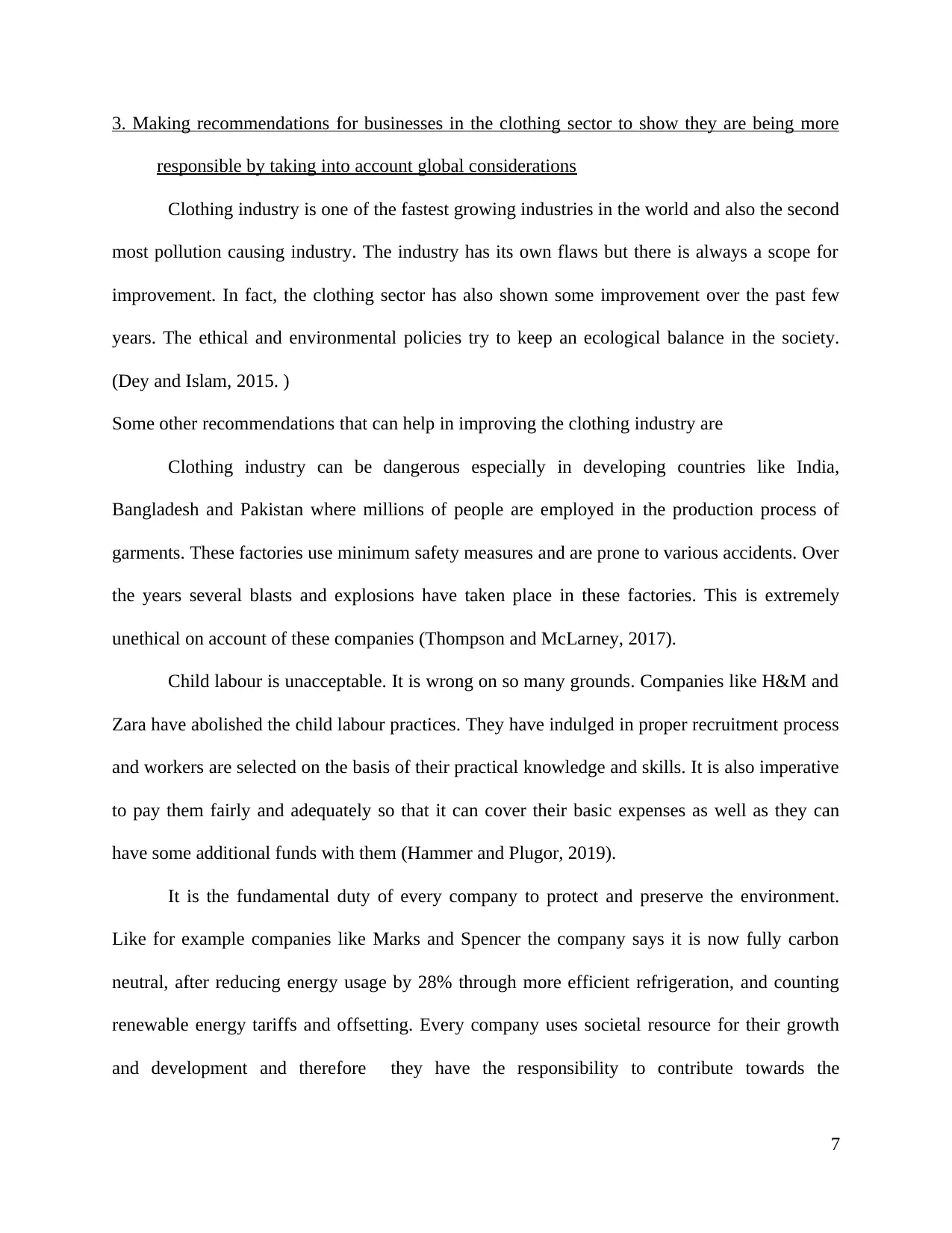
3. Making recommendations for businesses in the clothing sector to show they are being more
responsible by taking into account global considerations
Clothing industry is one of the fastest growing industries in the world and also the second
most pollution causing industry. The industry has its own flaws but there is always a scope for
improvement. In fact, the clothing sector has also shown some improvement over the past few
years. The ethical and environmental policies try to keep an ecological balance in the society.
(Dey and Islam, 2015. )
Some other recommendations that can help in improving the clothing industry are
Clothing industry can be dangerous especially in developing countries like India,
Bangladesh and Pakistan where millions of people are employed in the production process of
garments. These factories use minimum safety measures and are prone to various accidents. Over
the years several blasts and explosions have taken place in these factories. This is extremely
unethical on account of these companies (Thompson and McLarney, 2017).
Child labour is unacceptable. It is wrong on so many grounds. Companies like H&M and
Zara have abolished the child labour practices. They have indulged in proper recruitment process
and workers are selected on the basis of their practical knowledge and skills. It is also imperative
to pay them fairly and adequately so that it can cover their basic expenses as well as they can
have some additional funds with them (Hammer and Plugor, 2019).
It is the fundamental duty of every company to protect and preserve the environment.
Like for example companies like Marks and Spencer the company says it is now fully carbon
neutral, after reducing energy usage by 28% through more efficient refrigeration, and counting
renewable energy tariffs and offsetting. Every company uses societal resource for their growth
and development and therefore they have the responsibility to contribute towards the
7
responsible by taking into account global considerations
Clothing industry is one of the fastest growing industries in the world and also the second
most pollution causing industry. The industry has its own flaws but there is always a scope for
improvement. In fact, the clothing sector has also shown some improvement over the past few
years. The ethical and environmental policies try to keep an ecological balance in the society.
(Dey and Islam, 2015. )
Some other recommendations that can help in improving the clothing industry are
Clothing industry can be dangerous especially in developing countries like India,
Bangladesh and Pakistan where millions of people are employed in the production process of
garments. These factories use minimum safety measures and are prone to various accidents. Over
the years several blasts and explosions have taken place in these factories. This is extremely
unethical on account of these companies (Thompson and McLarney, 2017).
Child labour is unacceptable. It is wrong on so many grounds. Companies like H&M and
Zara have abolished the child labour practices. They have indulged in proper recruitment process
and workers are selected on the basis of their practical knowledge and skills. It is also imperative
to pay them fairly and adequately so that it can cover their basic expenses as well as they can
have some additional funds with them (Hammer and Plugor, 2019).
It is the fundamental duty of every company to protect and preserve the environment.
Like for example companies like Marks and Spencer the company says it is now fully carbon
neutral, after reducing energy usage by 28% through more efficient refrigeration, and counting
renewable energy tariffs and offsetting. Every company uses societal resource for their growth
and development and therefore they have the responsibility to contribute towards the
7
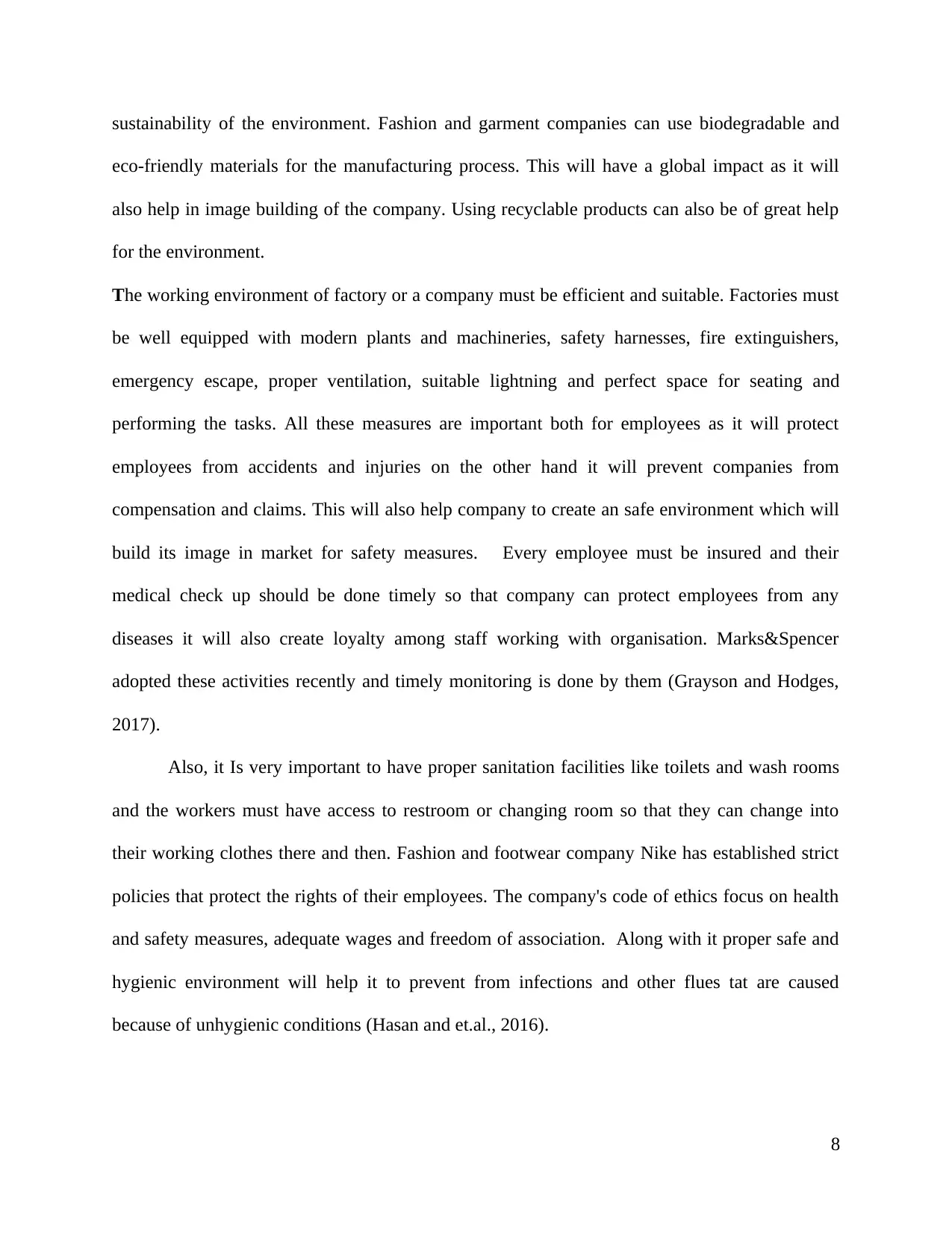
sustainability of the environment. Fashion and garment companies can use biodegradable and
eco-friendly materials for the manufacturing process. This will have a global impact as it will
also help in image building of the company. Using recyclable products can also be of great help
for the environment.
The working environment of factory or a company must be efficient and suitable. Factories must
be well equipped with modern plants and machineries, safety harnesses, fire extinguishers,
emergency escape, proper ventilation, suitable lightning and perfect space for seating and
performing the tasks. All these measures are important both for employees as it will protect
employees from accidents and injuries on the other hand it will prevent companies from
compensation and claims. This will also help company to create an safe environment which will
build its image in market for safety measures. Every employee must be insured and their
medical check up should be done timely so that company can protect employees from any
diseases it will also create loyalty among staff working with organisation. Marks&Spencer
adopted these activities recently and timely monitoring is done by them (Grayson and Hodges,
2017).
Also, it Is very important to have proper sanitation facilities like toilets and wash rooms
and the workers must have access to restroom or changing room so that they can change into
their working clothes there and then. Fashion and footwear company Nike has established strict
policies that protect the rights of their employees. The company's code of ethics focus on health
and safety measures, adequate wages and freedom of association. Along with it proper safe and
hygienic environment will help it to prevent from infections and other flues tat are caused
because of unhygienic conditions (Hasan and et.al., 2016).
8
eco-friendly materials for the manufacturing process. This will have a global impact as it will
also help in image building of the company. Using recyclable products can also be of great help
for the environment.
The working environment of factory or a company must be efficient and suitable. Factories must
be well equipped with modern plants and machineries, safety harnesses, fire extinguishers,
emergency escape, proper ventilation, suitable lightning and perfect space for seating and
performing the tasks. All these measures are important both for employees as it will protect
employees from accidents and injuries on the other hand it will prevent companies from
compensation and claims. This will also help company to create an safe environment which will
build its image in market for safety measures. Every employee must be insured and their
medical check up should be done timely so that company can protect employees from any
diseases it will also create loyalty among staff working with organisation. Marks&Spencer
adopted these activities recently and timely monitoring is done by them (Grayson and Hodges,
2017).
Also, it Is very important to have proper sanitation facilities like toilets and wash rooms
and the workers must have access to restroom or changing room so that they can change into
their working clothes there and then. Fashion and footwear company Nike has established strict
policies that protect the rights of their employees. The company's code of ethics focus on health
and safety measures, adequate wages and freedom of association. Along with it proper safe and
hygienic environment will help it to prevent from infections and other flues tat are caused
because of unhygienic conditions (Hasan and et.al., 2016).
8
Secure Best Marks with AI Grader
Need help grading? Try our AI Grader for instant feedback on your assignments.
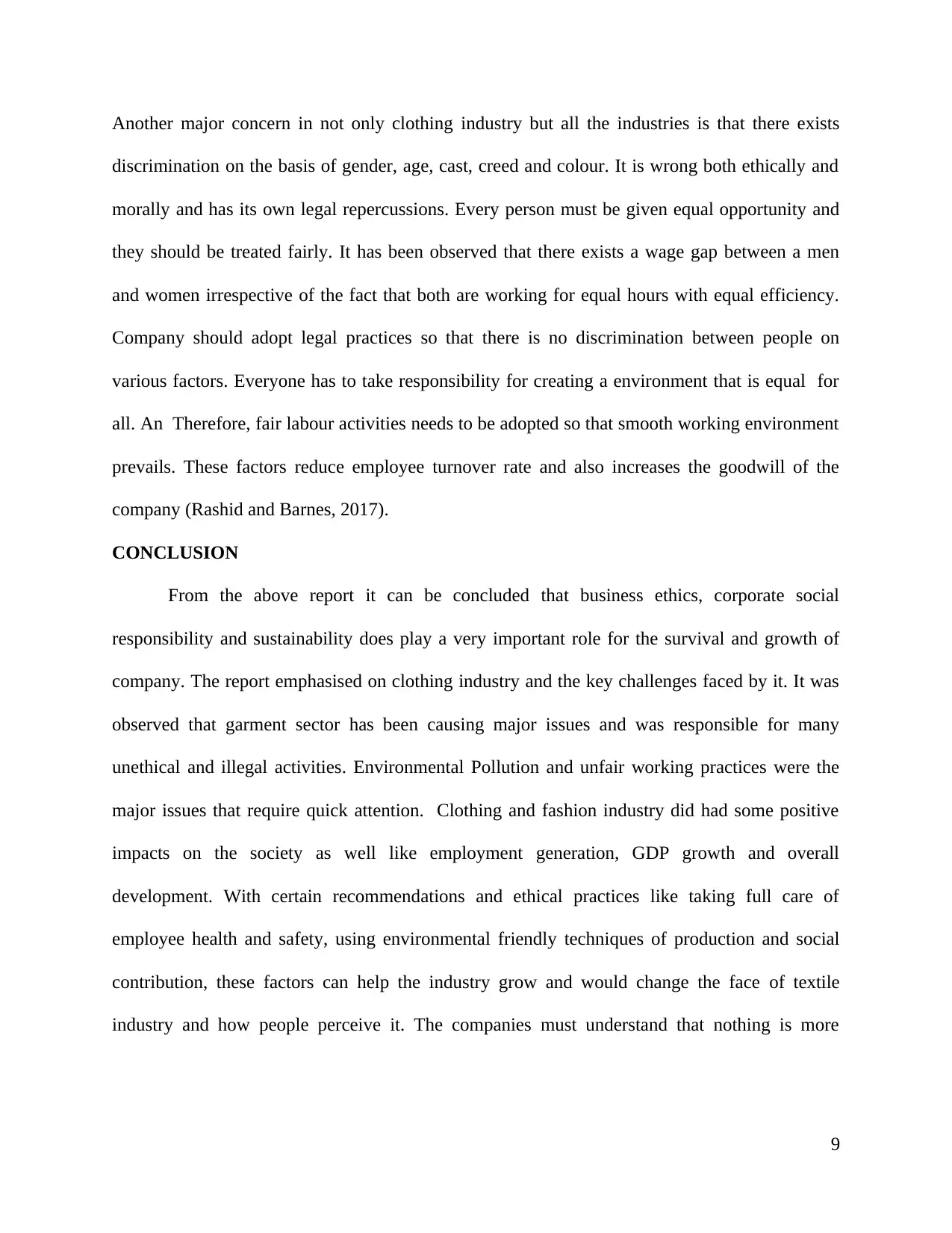
Another major concern in not only clothing industry but all the industries is that there exists
discrimination on the basis of gender, age, cast, creed and colour. It is wrong both ethically and
morally and has its own legal repercussions. Every person must be given equal opportunity and
they should be treated fairly. It has been observed that there exists a wage gap between a men
and women irrespective of the fact that both are working for equal hours with equal efficiency.
Company should adopt legal practices so that there is no discrimination between people on
various factors. Everyone has to take responsibility for creating a environment that is equal for
all. An Therefore, fair labour activities needs to be adopted so that smooth working environment
prevails. These factors reduce employee turnover rate and also increases the goodwill of the
company (Rashid and Barnes, 2017).
CONCLUSION
From the above report it can be concluded that business ethics, corporate social
responsibility and sustainability does play a very important role for the survival and growth of
company. The report emphasised on clothing industry and the key challenges faced by it. It was
observed that garment sector has been causing major issues and was responsible for many
unethical and illegal activities. Environmental Pollution and unfair working practices were the
major issues that require quick attention. Clothing and fashion industry did had some positive
impacts on the society as well like employment generation, GDP growth and overall
development. With certain recommendations and ethical practices like taking full care of
employee health and safety, using environmental friendly techniques of production and social
contribution, these factors can help the industry grow and would change the face of textile
industry and how people perceive it. The companies must understand that nothing is more
9
discrimination on the basis of gender, age, cast, creed and colour. It is wrong both ethically and
morally and has its own legal repercussions. Every person must be given equal opportunity and
they should be treated fairly. It has been observed that there exists a wage gap between a men
and women irrespective of the fact that both are working for equal hours with equal efficiency.
Company should adopt legal practices so that there is no discrimination between people on
various factors. Everyone has to take responsibility for creating a environment that is equal for
all. An Therefore, fair labour activities needs to be adopted so that smooth working environment
prevails. These factors reduce employee turnover rate and also increases the goodwill of the
company (Rashid and Barnes, 2017).
CONCLUSION
From the above report it can be concluded that business ethics, corporate social
responsibility and sustainability does play a very important role for the survival and growth of
company. The report emphasised on clothing industry and the key challenges faced by it. It was
observed that garment sector has been causing major issues and was responsible for many
unethical and illegal activities. Environmental Pollution and unfair working practices were the
major issues that require quick attention. Clothing and fashion industry did had some positive
impacts on the society as well like employment generation, GDP growth and overall
development. With certain recommendations and ethical practices like taking full care of
employee health and safety, using environmental friendly techniques of production and social
contribution, these factors can help the industry grow and would change the face of textile
industry and how people perceive it. The companies must understand that nothing is more
9
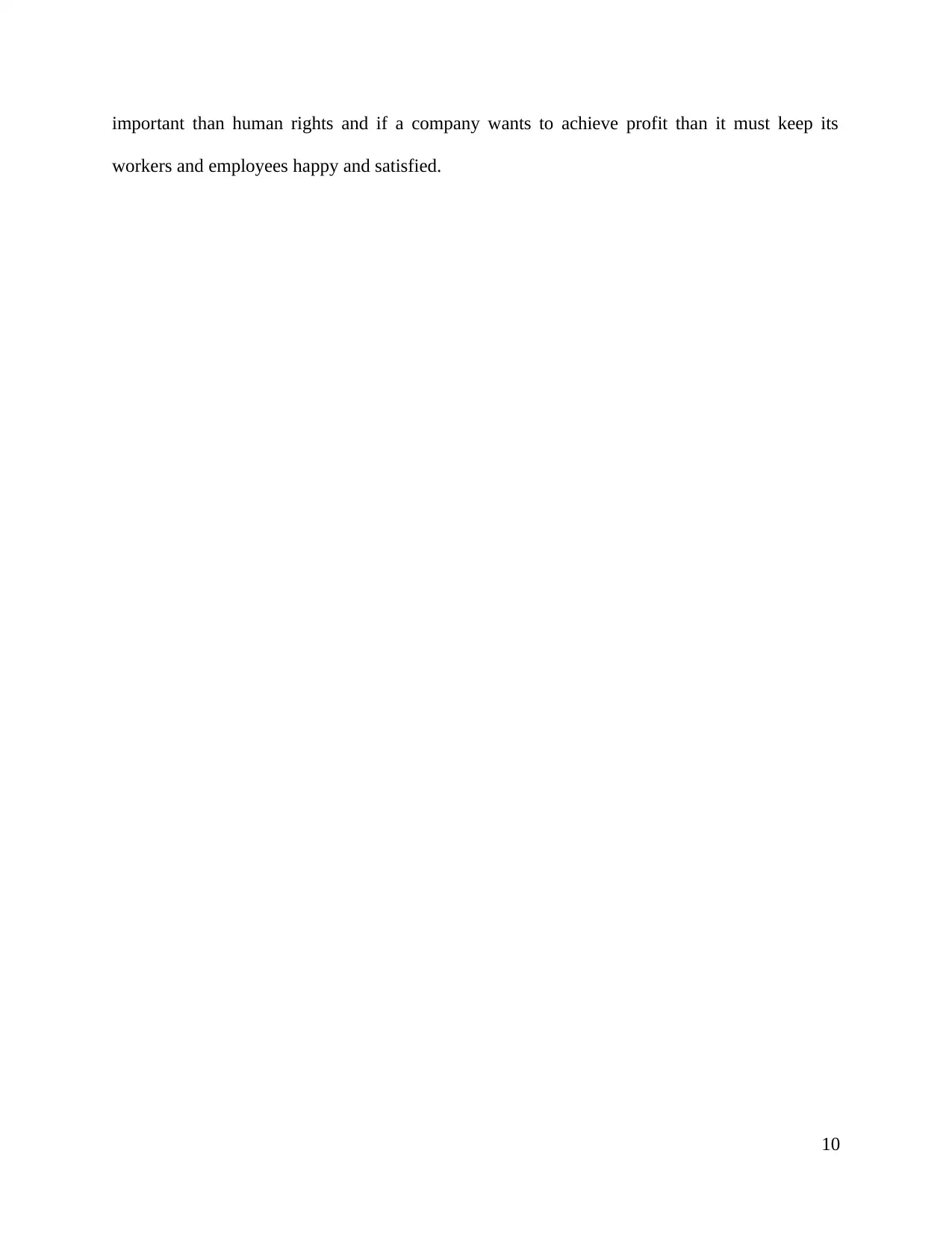
important than human rights and if a company wants to achieve profit than it must keep its
workers and employees happy and satisfied.
10
workers and employees happy and satisfied.
10
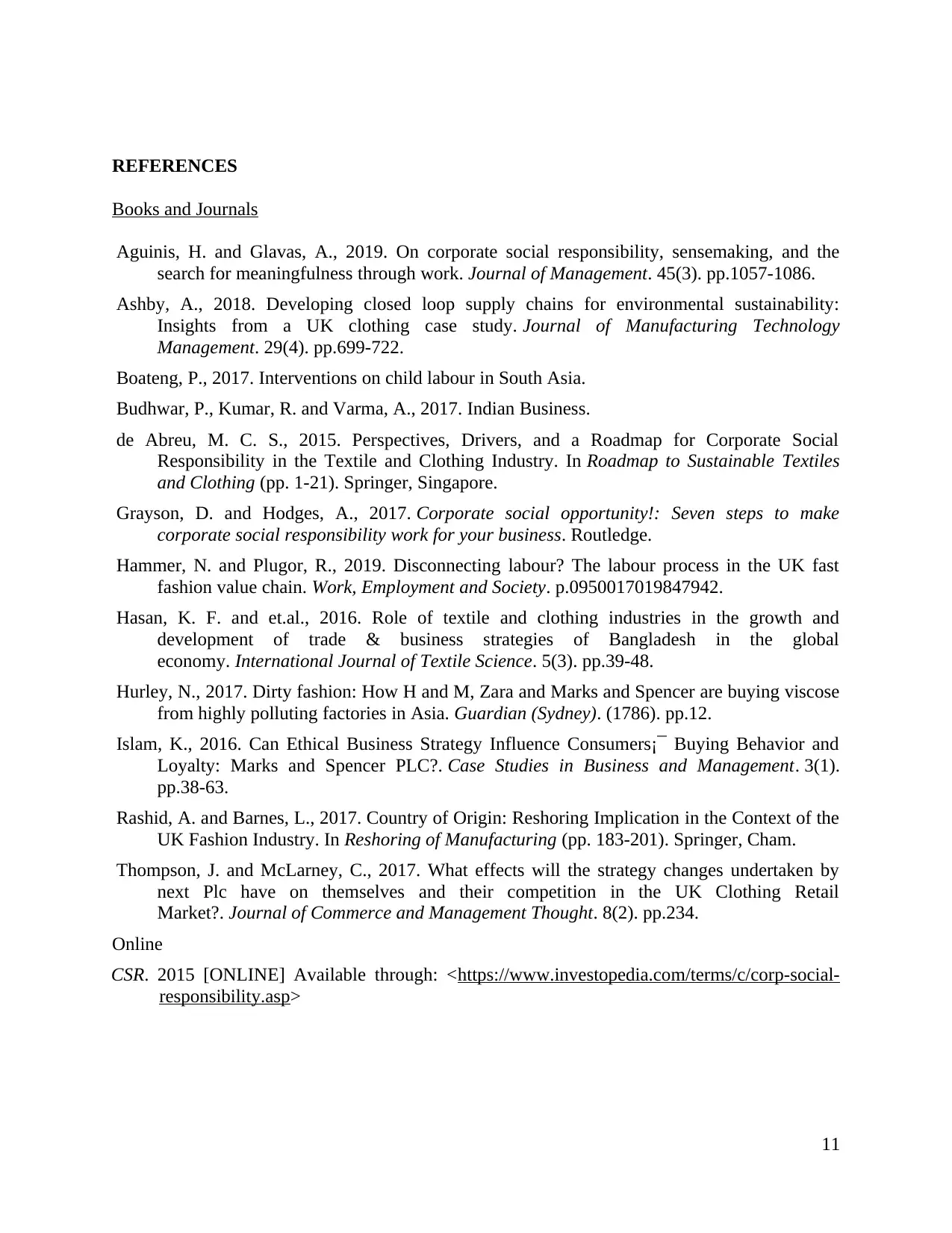
REFERENCES
Books and Journals
Aguinis, H. and Glavas, A., 2019. On corporate social responsibility, sensemaking, and the
search for meaningfulness through work. Journal of Management. 45(3). pp.1057-1086.
Ashby, A., 2018. Developing closed loop supply chains for environmental sustainability:
Insights from a UK clothing case study. Journal of Manufacturing Technology
Management. 29(4). pp.699-722.
Boateng, P., 2017. Interventions on child labour in South Asia.
Budhwar, P., Kumar, R. and Varma, A., 2017. Indian Business.
de Abreu, M. C. S., 2015. Perspectives, Drivers, and a Roadmap for Corporate Social
Responsibility in the Textile and Clothing Industry. In Roadmap to Sustainable Textiles
and Clothing (pp. 1-21). Springer, Singapore.
Grayson, D. and Hodges, A., 2017. Corporate social opportunity!: Seven steps to make
corporate social responsibility work for your business. Routledge.
Hammer, N. and Plugor, R., 2019. Disconnecting labour? The labour process in the UK fast
fashion value chain. Work, Employment and Society. p.0950017019847942.
Hasan, K. F. and et.al., 2016. Role of textile and clothing industries in the growth and
development of trade & business strategies of Bangladesh in the global
economy. International Journal of Textile Science. 5(3). pp.39-48.
Hurley, N., 2017. Dirty fashion: How H and M, Zara and Marks and Spencer are buying viscose
from highly polluting factories in Asia. Guardian (Sydney). (1786). pp.12.
Islam, K., 2016. Can Ethical Business Strategy Influence Consumers¡¯ Buying Behavior and
Loyalty: Marks and Spencer PLC?. Case Studies in Business and Management. 3(1).
pp.38-63.
Rashid, A. and Barnes, L., 2017. Country of Origin: Reshoring Implication in the Context of the
UK Fashion Industry. In Reshoring of Manufacturing (pp. 183-201). Springer, Cham.
Thompson, J. and McLarney, C., 2017. What effects will the strategy changes undertaken by
next Plc have on themselves and their competition in the UK Clothing Retail
Market?. Journal of Commerce and Management Thought. 8(2). pp.234.
Online
CSR. 2015 [ONLINE] Available through: <https://www.investopedia.com/terms/c/corp-social-
responsibility.asp>
11
Books and Journals
Aguinis, H. and Glavas, A., 2019. On corporate social responsibility, sensemaking, and the
search for meaningfulness through work. Journal of Management. 45(3). pp.1057-1086.
Ashby, A., 2018. Developing closed loop supply chains for environmental sustainability:
Insights from a UK clothing case study. Journal of Manufacturing Technology
Management. 29(4). pp.699-722.
Boateng, P., 2017. Interventions on child labour in South Asia.
Budhwar, P., Kumar, R. and Varma, A., 2017. Indian Business.
de Abreu, M. C. S., 2015. Perspectives, Drivers, and a Roadmap for Corporate Social
Responsibility in the Textile and Clothing Industry. In Roadmap to Sustainable Textiles
and Clothing (pp. 1-21). Springer, Singapore.
Grayson, D. and Hodges, A., 2017. Corporate social opportunity!: Seven steps to make
corporate social responsibility work for your business. Routledge.
Hammer, N. and Plugor, R., 2019. Disconnecting labour? The labour process in the UK fast
fashion value chain. Work, Employment and Society. p.0950017019847942.
Hasan, K. F. and et.al., 2016. Role of textile and clothing industries in the growth and
development of trade & business strategies of Bangladesh in the global
economy. International Journal of Textile Science. 5(3). pp.39-48.
Hurley, N., 2017. Dirty fashion: How H and M, Zara and Marks and Spencer are buying viscose
from highly polluting factories in Asia. Guardian (Sydney). (1786). pp.12.
Islam, K., 2016. Can Ethical Business Strategy Influence Consumers¡¯ Buying Behavior and
Loyalty: Marks and Spencer PLC?. Case Studies in Business and Management. 3(1).
pp.38-63.
Rashid, A. and Barnes, L., 2017. Country of Origin: Reshoring Implication in the Context of the
UK Fashion Industry. In Reshoring of Manufacturing (pp. 183-201). Springer, Cham.
Thompson, J. and McLarney, C., 2017. What effects will the strategy changes undertaken by
next Plc have on themselves and their competition in the UK Clothing Retail
Market?. Journal of Commerce and Management Thought. 8(2). pp.234.
Online
CSR. 2015 [ONLINE] Available through: <https://www.investopedia.com/terms/c/corp-social-
responsibility.asp>
11
1 out of 13
Related Documents
Your All-in-One AI-Powered Toolkit for Academic Success.
+13062052269
info@desklib.com
Available 24*7 on WhatsApp / Email
![[object Object]](/_next/static/media/star-bottom.7253800d.svg)
Unlock your academic potential
© 2024 | Zucol Services PVT LTD | All rights reserved.





